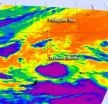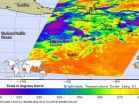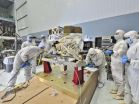(Press-News.org) Jerusalem, June 14, 2012 – How do grasshoppers who are being frightened by spiders affect our ecosystem? In no small measure, say researchers at the Hebrew University of Jerusalem and at Yale University in the US.
A grasshopper who is in fear of an attacker, such as a spider, will enter a situation of stress and will consume a greater quantity of carbohydrate-rich plants – similar to humans under stress who might eat more sweets.
This type of reaction will, in turn, cause chemical changes in the grasshopper and in its excretions, affecting the ecosystem it inhabits. How does this happen?
When the scared grasshopper dies, its carcass, now containing less nitrogen as a result of its diet change, will have an effect on the microbes in the ground, which are responsible for breaking down animals and plants.
With less nitrogen available, the microbes will be decomposing the hard-to-break-down plant materials in the soil at a slower rate. Thus, the fear of predation may slow down degradation of complex organic materials to the simpler compounds required for plant growth.
Research on this biological-ecological phenomenon was carried out by Dr. Dror Halwena of the Department of Ecology, Evolution and Behavior at the Alexander Silberman Institute of Life Sciences at the Hebrew University of Jerusalem, in cooperation with researchers at Yale University in the United States. An article on their research appears in the current edition of the journal Science.
In their research, the scientists exposed grasshoppers to spiders in order to arouse the stress reaction. They also used a control group of non-stressed grasshoppers. The scared grasshoppers had a higher carbon-to-nitrogen ratio in their bodies than non-scared grasshoppers.
In further laboratory and field tests, the researchers tested the influence of remains of grasshoppers from the two groups on soil. After the microbes consumed the grasshopper remains, the researchers added plants to the surface. In the experiments, it was shown that the decomposition rate of the plants in the areas in which the stress-free grasshopper remains were introduced decomposed at a rate between 62 and 200 percent faster than in the samples in which the stressed grasshopper s were put.
In a further experiment, the researchers used "artificial grasshoppers" – a mixture of sugar, protein, and chitin (the organic compound found in the grasshopper external skeleton) -- in varying quantities. Here, too, they found that even a small amount of nitrogen (found in the protein) added to the soil increases significantly the functioning of the microbes responsible for breaking down the organic matter in plants.
"We are dealing here with an absolutely new kind of mechanism whereby every small chemical change in a creature can regulate the natural cycle, thus in effect affecting the ecology in total, such as the amount of carbon dioxide released into the atmosphere (through decomposition) and field crop productivity. This has tremendous consequences for our ecological understanding of the living world," said Dr. Halwena.
"We are gaining a greater understanding of the necessity of conserving all of the component parts of the ecosystem in general and of predators in particular. We are losing predators in nature at a much faster rate than other species," Dr. Halwena commented.
He also viewed the research as a vehicle that will enable scientists to better predict changes in the biological system as a result of such human-induced phenomenon as overfishing, hunting or global warming that can undermine the entire ecosystem.
INFORMATION:
Grasshoppers 'stressed' by spiders affect the productivity of our soil
Researchers from Hebrew University, Yale show
2012-06-15
ELSE PRESS RELEASES FROM THIS DATE:
Virtual colonoscopy without laxative equals standard in identifying clinically significant polyps
2012-06-15
Computed tomographic colonography (CTC), also known as virtual colonoscopy, administered without laxatives is as accurate as conventional colonoscopy in detecting clinically significant, potentially cancerous polyps, according to a study performed jointly at the San Francisco VA Medical Center, the University of California, San Francisco and Massachusetts General Hospital.
"I think we have demonstrated that laxative-free CTC is a valid tool for detecting polyps that are clinically significant," said co-author and site principal investigator Judy Yee, MD, chief of radiology ...
Catching some rays
2012-06-15
Drawn together by the force of nature, but pulled apart by the force of man – it sounds like the setting for a love story, but it is also a basic description of how scientists have begun to make more efficient organic solar cells.
At the atomic level, organic solar cells function like the feuding families in Romeo and Juliet. There's a strong natural attraction between the positive and negative charges that a photon generates after it strikes the cell, but in order to capture the energy, these charges need to be kept separate.
When these charges are still bound together, ...
Hidden vitamin in milk yields remarkable health benefits
2012-06-15
NEW YORK (June 14, 2012) — A novel form of vitamin B3 found in milk in small quantities produces remarkable health benefits in mice when high doses are administered, according to a new study conducted by researchers at Weill Cornell Medical College and the Polytechnic School in Lausanne, Switzerland.
The findings, recently reported in the June 2012 issue of the journal, Cell Metabolism, reveal that high doses of the vitamin precursor, nicotinamide riboside (NR) — a cousin of niacin — prevent obesity in mice that are fed a fatty diet, and also increase muscle performance, ...
Study suggests expanded concept of 'urban watershed'
2012-06-15
BALTIMORE, Md., June 14, 2012 – Within two decades, 60 percent of the world's population will live in cities, and coping with the resulting urban drinking water and sanitation issues will be one of the greatest challenges of this century. A U.S. Forest Service study recently published in Urban Ecosystems proposes an expanded view of the complex world of urban water.
The study presents a new conceptual framework that addresses characteristics of watersheds that are affected by urban land uses, including:
hydrologic connectivity between aquatic and terrestrial ecosystems ...
Researchers outline plan to end preventable child deaths in a generation
2012-06-15
Preventable childhood deaths caused by illnesses such as pneumonia and diarrhea can be nearly eliminated in 10 years according to researchers from the Johns Hopkins Bloomberg School of Public Health and the National Institutes of Health. In a new commentary featured in the June issue of the Journal of the American Medical Association, researchers outline a strategy and benchmarks for curbing childhood preventable deaths and recommend a new common vision for a global commitment to end all preventable child deaths.
Developed in 2000 by the United Nations, eight Millennium ...
Guchol is a tiny typhoon on NASA satellite imagery
2012-06-15
Tropical Storm Guchol intensified into a typhoon and is a compact system. It appears as a strong, small typhoon in infrared NASA satellite imagery today.
NASA's Aqua satellite flew over Typhoon Guchol on June 13 and 14 and captured an infrared view of the storm's clouds and temperatures. The Atmospheric Infrared Sounder (AIRS) instrument that flies on NASA's Aqua satellite captured infrared and temperature data on Guchol. When cloud temperatures get colder, it means that clouds are getting higher. The lowest temperatures were as cold as or colder than 220 degrees Kelvin ...
NASA sees bitter cold cloud tops in newborn Tropical Storm Carlotta
2012-06-15
Bitter cold cloud tops tell forecasters that a storm has a lot of uplift, and the colder the cloud tops, the higher they are in the atmosphere, and the stronger the thunderstorms. NASA's Aqua satellite data showed that the cloud top temperatures in newborn Tropical Storm Carlotta became colder overnight and continue to grow colder as the low pressure area formely known as System 94E strengthened into a tropical storm. Carlotta is even expected to strengthen further and become a hurricane.
Because Carlotta is expected to continue strengthening, the government of Mexico ...
Chance alignment between galaxies mimics a cosmic collision
2012-06-15
NASA's Hubble Space Telescope shows a rare view of a pair of overlapping galaxies, called NGC 3314. The two galaxies look as if they are colliding, but they are actually separated by tens of millions of light-years, or about ten times the distance between our Milky Way and the neighboring Andromeda galaxy. The chance alignment of the two galaxies, as seen from Earth, gives a unique look at the silhouetted spiral arms in the closer face-on spiral, NGC 3314A.
The motion of the two galaxies indicates that they are both relatively undisturbed and that they are moving in markedly ...
First flight instrument delivered for James Webb
2012-06-15
The first of four instruments to fly aboard NASA's James Webb Space Telescope (Webb) has been delivered to NASA. The Mid-Infrared Instrument (MIRI) will allow scientists to study cold and distant objects in greater detail than ever before.
MIRI arrived at NASA's Goddard Space Flight Center in Greenbelt, Md., May 29. It has been undergoing inspection before being integrated into Webb's science instrument payload known as the Integrated Science Instrument Module (ISIM).
Assembled at and shipped from the Science and Technology Facilities Council's Rutherford Appleton Laboratory ...
New solar active region spitting out flares
2012-06-15
An active region on the sun, numbered AR 1504, rotated into view over the left side of the sun on June 10, 2012. The region fired off two M-class flares and two coronal mass ejections (CMEs) on June 13 and June 14, 2012. The first flare lasted for a relatively long three hours, peaking on June 13, 2012 at 9:17 AM EDT. The associated CME traveled at approximately 375 miles per second and is directed toward Earth, though due to its slow speed, the effect on Earth is expected to be minimal.
The second M-class flare was also a long-duration flare, and it peaked on June 14, ...
LAST 30 PRESS RELEASES:
The Ceramic Society of Japan’s Oxoate Ceramics Research Association launches new international book project
Heart-brain connection: international study reveals the role of the vagus nerve in keeping the heart young
Researchers identify Rb1 as a predictive biomarker for a new therapeutic strategy in some breast cancers
Survey reveals ethical gaps slowing AI adoption in pediatric surgery
Stimulant ADHD medications work differently than thought
AI overestimates how smart people are, according to HSE economists
HSE researchers create genome-wide map of quadruplexes
Scientists boost cell "powerhouses" to burn more calories
Automatic label checking: The missing step in making reliable medical AI
Low daily alcohol intake linked to 50% heightened mouth cancer risk in India
American Meteorological Society announces Rick Spinrad as 2026 President-Elect
Biomass-based carbon capture spotlighted in newly released global climate webinar recording
Illuminating invisible nano pollutants: advanced bioimaging tracks the full journey of emerging nanoscale contaminants in living systems
How does age affect recovery from spinal cord injury?
Novel AI tool offers prognosis for patients with head and neck cancer
Fathers’ microplastic exposure tied to their children’s metabolic problems
Research validates laboratory model for studying high-grade serous ovarian cancer
SIR 2026 delivers transformative breakthroughs in minimally invasive medicine to improve patient care
Stem Cell Reports most downloaded papers of 2025 highlight the breadth and impact of stem cell research
Oxford-led study estimates NHS spends around 3% of its primary and secondary care budget on the health impacts of heat and cold in England
A researcher’s long quest leads to a smart composite breakthrough
Urban wild bees act as “microbial sensors” of city health.
New study finds where you live affects recovery after a hip fracture
Forecasting the impact of fully automated vehicle adoption on US road traffic injuries
Alcohol-related hospitalizations from 2016 to 2022
Semaglutide and hospitalizations in patients with obesity and established cardiovascular disease
Researchers ‘listen in’ to embryo-mother interactions during implantation using a culture system replicating the womb lining
How changing your diet could help save the world
How to make AI truly scalable and reliable for real-time traffic assignment?
Beyond fragmented markets: A new framework for efficient and stable ride-pooling
[Press-News.org] Grasshoppers 'stressed' by spiders affect the productivity of our soilResearchers from Hebrew University, Yale show






